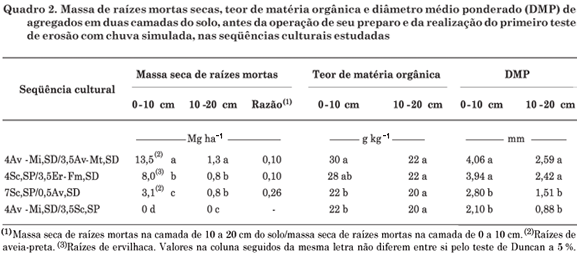Increasing underground plant biomass and soil aggregate stability by application of adequate management practices enhances the quality in terms of water infiltration and erosion resistance. Based on this premise, an erosion study using simulated rainfall was carried out in the field, at an experimental station of the Universidade Federal do Rio Grande do Sul - EEA/UFRGS), in Eldorado do Sul, Rio Grande do Sul State, Brazil, in the summer of 2003/2004, in a 7.5 year soil management experiment. The purpose of the research was to investigate relationships between management and erosion variables, related to a given history of soil use and management and to the momentary, surface physical conditions created by tillage and residue-cover treatments, applied immediately before erosion tests. A sandy clay loam Ultisol with 0.115 m m-1 average slope steepness was used. Four crop sequences were studied in no-till, under tillage (disking) and under mulch-cover (crop residue). Three erosion tests of simulated rainfall were performed with a rotating-boom rainfall simulator, each of them at a rainfall intensity of 64 mm h-1 during 1.5 h. The root mass of dead plants, soil aggregate mean-weight diameter, soil and water loss were determined. In the freshly-tilled soil (loose and rough surface) water infiltration in the soil was higher, contrasting with the lower water loss than in the untilled soil (firm and smooth surface), even though the former was bare and the later was either bare or mulched. There were also differences among the crop sequences. Soil loss was small in all crop sequences in the untilled, mulch-covered soil, while in the bare, untilled or freshly-tilled soil it was only small in the crop sequences that produced high amounts of dead plant root mass and where the soil aggregate mean-weight diameter was high. In the freshly-tilled, bare soil with high values of these two latter variables, the decrease in soil loss was due to the surface roughness created by tillage. The relationships of total water loss (declining) and total soil loss with dead plant root mass and with soil aggregate mean-weight diameter were significant at 5 %.
simulated rainfall; crop sequence; soil tillage; soil cover; water infiltration; water loss; soil loss









